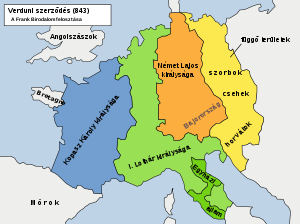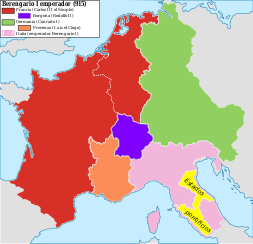History:France during the 900s
In the Middle Ages, West Francia (Later The Kingdom of France) in the 900s, was a period in France starting from the year 900 and ending in 999. This period saw the first century after the fall of the Carolingian Empire. The creation of the House of Capet, the foundation of the Cluny Abbey in 910, The Hungarian raids towards France and Burgundy starting in 913, and the many Viking raids that plagued northern and southern France.
France Before 900
After the first division of the Carolingian Empire in 843, West Francia was born under the reign of Charles the Bald. After the creation of new states, the Vikings to the north used their longboats to sail expeditions in areas like the Loire and the Seine.
The Franks were first attacked by Vikings in 799, after this attack Charlemagne Of the Carolingian Empire would create a defense system. Vikings from Denmark would be able to trespass those defenses and attack areas in Frisia and Dorestad. In 845 the Vikings attacked and sieged Paris.
Treaty of Prüm
On the 19th of September 855 the Treaty of Prüm was signed as a second partition of Lotharingia while the King Lothair I would reach the final days of his lifetime. In 870 the Treaty of Meerssen divided up Middle Francia between West and East Francia, with the aim to partition the duchy of Lothair II.
Siege of Paris
In 885 another Viking raid on Paris began, this time led by Rollo, Ruler of Normandy. However the French built many city walls across the outer regions of the city and were successfully able to defend the city and drive back the Vikings to Burgundy.[1] [2]
During late 887 Charles the Fat was deposed by Arnulf of Carinthia, his nephew, after 2 months he died of natural causes. In 893, Charles the Simple, now 14, was crowned the King of France at Reims Cathedral.
France, 900 - 999
900 - 920
Starting in 911, Rollo sails his men towards the Seine and they travel across the Loire and the Garonne. Later on the 20th of July Rollo uses 20,000 of his men to besiege the city of Chartes. With help from Richard, Duke of Burgundy, the Western Frankish horsemen now counter attacked the 20,000 Viking force. They were able to board on ships to advance at a meteoric speed. Rollo and his horsemen/infantry would make a fortification wall across the city.
Formation of Normandy
With the French being repulsed and inadequate, they attempted peace negotiations with Rollo and his 14,000 men (6,000 of them were lost). The Vikings convinced Charles III to become beneficial allies in the future. So the siege ended and both sides drafted up the Treaty of Saint-Clair-sur-Epte, establishing the Duchy of Normandy who would later go on to invade England, also making Rollo the duke of the new country. The talks before the treaty also granted him Britany, a country where the French attempted to conquer but failed, thus making him the new king.
In 912, Charles III defended his country against a two sided attack against Conrad, King of the Germans, along with making his successor, Henry the Fowler to recognize the ethicalness of his jurisdiction in an interview they had on a small raft on the Rhine river at the city of Bonn.
Hungarian invasion
Between 915 and 919, Hungarian invaders from the West began attacking areas in Eastern France, and according to one Saxonian chronicle, Charles and his army attacked Saxony, possibly using the River Lippe to his advantage, in 917, Hungarian armies moved towards France once again, specifically invading the duchy of Alsace. The next month their armies moved towards the city of Verdun and captured Lotharingia.
With Charles becoming more in favor of Hagano, a Lotharignian noble, revolt begin betwixt 919 - 922, the Normans took advantage of this to raid areas in Northern France, Charles, having heavy support for Hagano alienated Frankish moguls who had expected to have a bigger play in counseling the king to lead the country. During late 919 and early 920 the Hungarians ravaged areas across Francia.[3]
References
- ↑ Chronological Look at the History of France. Editions Jean-paul Gisserot. 2001. ISBN 9782877475624. https://www.google.com/books/edition/Chronological_Look_at_the_History_of_Fra/13beuZ0pB8cC?hl=en&gbpv=0.
- ↑ The history of France, from the earliest period. https://www.google.com/books/edition/The_history_of_France_from_the_earliest/CKak4Olp-SQC?hl=en&gbpv=1&dq=Division+of+France+between+Charles+the+Simple+and+Eudes&pg=PA25&printsec=frontcover.
- ↑ Families, Friends and Allies Boulogne and Politics in Northern France and England, C.879-1160




